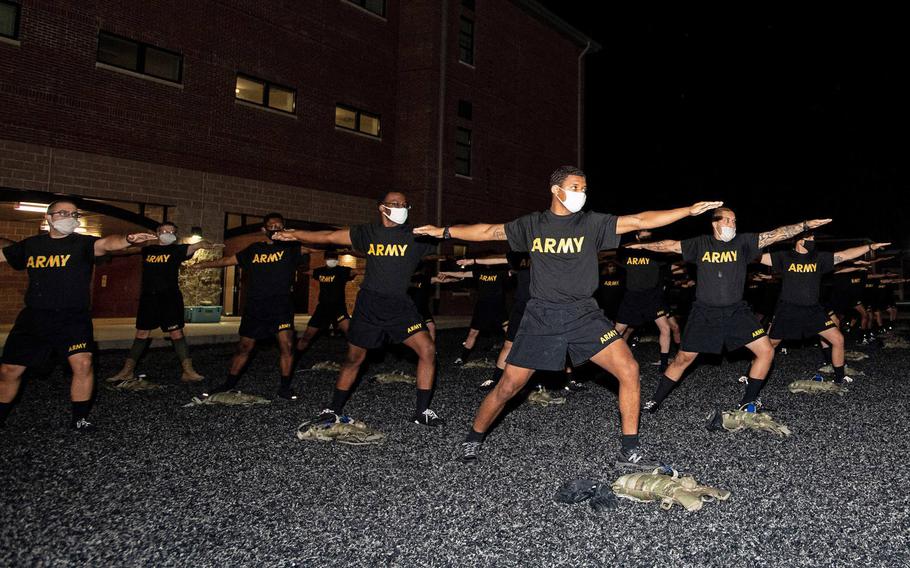
Trainees with 3rd Battalion, 34th Infantry Regiment participate in yoga training on Oct. 29, 2020. The Army is evaluating whether a pilot program incorporating yoga and meditation aided basic training platoons. (Josephine Carlson/U.S. Army)
The Army is studying whether the warrior pose could make better warriors after putting hundreds of new recruits through daily yoga and meditation regimens in basic training.
The 10-week pilot program was designed to evaluate possible military benefits of the practices rooted in ancient eastern pacifist philosophies, as the service seeks to address declining fitness among military recruits.
Soldiers in 20 basic training platoons at Fort Jackson, S.C., practiced yoga and meditation daily to assess their effects on factors like physical performance, mental toughness, soldier discipline, injury rates, stress management and graduation rates.
“We realized there’s growing scientific evidence that mindfulness and yoga have positive effects on individual holistic health and fitness,” said Maj. Kimberley Jordan, a doctor of physical therapy and the officer overseeing the program. “The basic combat training environment … was rich in a variety of performance indicators that we could assess or analyze.”
Fort Jackson’s 3rd Battalion, 34th Infantry Regiment and 2nd Battalion, 60th Infantry Regiment each had 20 platoons participating, 10 as the test group and 10 as a control group, for a total of about 1,800 participants.
It’s one of the few studies on yoga in the military and one of the largest on mindfulness, Jordan said. Researchers were crunching numbers from data collected last fall and final results are expected later this year.
Early feedback suggests improved endurance on ruck marches and obstacle courses, reduced pain during recovery periods and better management of stress and homesickness, said Jordan, who’s used yoga herself for injury recovery and has included it in treatment for some of her patients.
While linked to Hindu and Buddhist traditions, the practices and poses taught were stripped of religious references. Chaplains were also consulted, she said.
Led by contracted trainers, half the trainees did yoga for 15 minutes before and after normal morning physical training exercises — poses like downward dog, plank and chair positions. They also received two hours of weekly instruction in mindfulness in the first four weeks and practiced meditation six days a week for 15 minutes before lights out, for the duration of the program.
The control group platoons used standard Army preparation and recovery drills, such as windmill stretches, bend-and-reach and pushups. Both groups and their drill sergeants took several surveys to gauge their attitudes on the program.
“I’m sorry, did you say yoga?” Pfc. Joe Skeen said in a video on his popular TikTok account last month, responding to a post by a user named @pastelsoldier who apparently participated in the study.
Skeen, who has about 735,000 followers on the app, joked that the only yoga he might’ve done in his training was the downward dog pose while being punished.
In comments on Skeen’s video, @pastelsoldier said she preferred the normal physical fitness training because it was actually easier.
Another trainee initially didn’t think yoga and the Army went together, but soon changed her mind, the Army said in a December statement.
“I started really enjoying and benefiting from the positions,” Pfc. Lina Alani said in the statement.
Mindfulness practices outside of nightly meditation, such as when standing for long periods at attention or on ruck marches, “really helped me focus on the task at hand,” she said.
The yoga training aligned with the Army’s new comprehensive health and fitness program, introduced to accompany the service’s first overhaul of its fitness test in four decades. The Holistic Health and Fitness System is intended to help reduce injuries, obesity, chronic sleep deprivation and mental illness, an Army statement said.
Declining fitness among American youth, including huge jumps in the rate of first-time failures on modified fitness tests given to basic trainees from 2000 to 2010, was also cited as driving the need for a new approach.
Aside from fitness benefits, yoga may have other practical military training applications. For example, some soldiers were taught to strike the wide archer-like stance of the warrior pose to help stabilize themselves when firing from behind barriers during marksmanship training.
And trainees who did mindfulness training showed signs of better behavior, said Sgt. 1st Class Desiree Strickland, a drill sergeant quoted in the December statement.
“They don’t argue,” she said. “They overall have more respect for themselves, each other and for the drill sergeants.”
However, some participants said they would’ve rather used the time to prepare for other activities.
“The trainees looked discouraged or upset because they had to sit through 15 minutes of mindfulness,” said Staff Sgt. Angela Alvarez, another drill sergeant quoted in the statement.
There are no plans yet for additional cycles of the pilot program, Jordan said, but its results will help Training and Doctrine Command decide on whether to continue use of yoga and mindfulness training.
garland.chad@stripes.com Twitter: @chadgarland